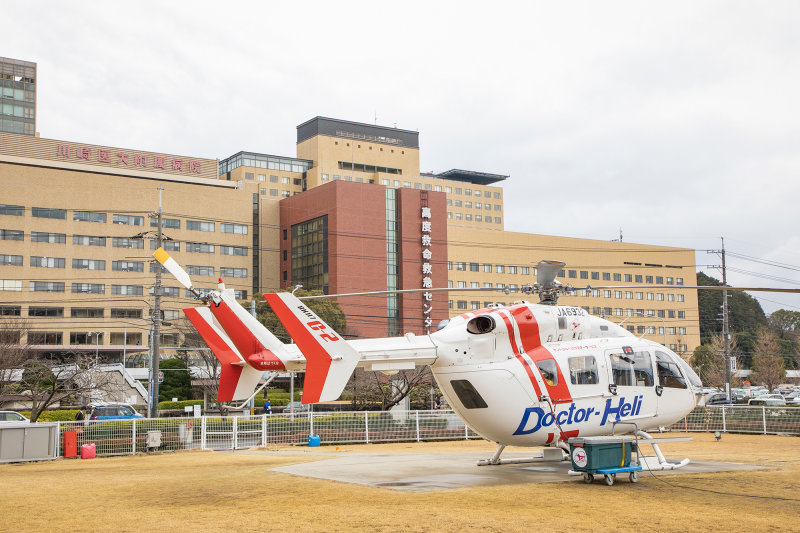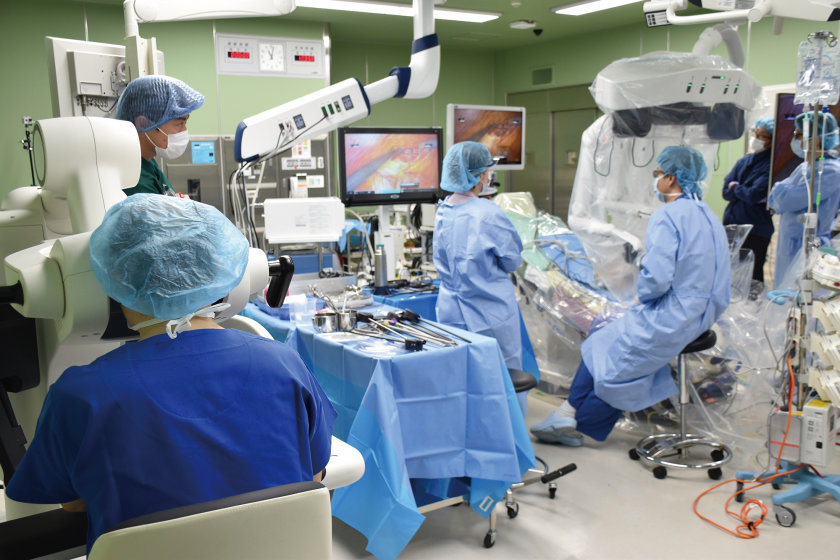Immediate Transport of Physician to an Emergency Behind-the-Scenes Stories of EMS Helicopters Saving Lives

Helicopters dedicated to emergency medical services (HEMS) not only transport patients but also carry physicians to the emergency site so that prompt treatment starts as soon as possible. A popular TV drama series in Japan about HEMS made the role of emergency care flights generally acknowledged. Kawasaki’s BK117 Series helicopters account for about 50% of this HEMS serving in Japan. This article presents the facts and reports on the fieldwork of the lifesaving wings—the EMS helicopters actively working on the frontline of emergency medical care.
Introduced in Japan after the Great Hanshin-Awaji Earthquake. Kawasaki Medical School Hospital starts operations in 2001
An EMS helicopter is defined in a government act as a “system whereby a helicopter equipped with medical devices and pharmaceuticals transports physicians and nurses to an emergency site and then transports patients to an appropriate medical institution after providing medical care at the scene.” In addition to emergency dispatch, EMS helicopters transport patients from one medical institution to another for more advanced medical care as inter-facility transport when needed.
The world’s first EMS helicopter went into service in 1952 in Switzerland to rescue victims of mountaineering accidents for transport to hospitals. In Japan, two hospitals in Kanagawa and Okayama prefectures initiated trial service of EMS helicopters as a model project of the Japanese Ministry of Health, Labour, and Welfare (MHLW) in 1999.
The introduction was triggered by the Great Hanshin-Awaji Earthquake of 1995. Since the earthquake destroyed the roads in many areas, ambulances had difficulty reaching victims; consequently, disaster relief helicopters were expected to provide rescue services. However, only one victim was transferred on the first day and as few as 17 persons in total in three days. As a result, voices calling for helicopters specialized in emergency medical services to provide medical aid in disasters increased and led to the full-scale deployment of EMS helicopters.
Flight operations officially began in 2001. Kawasaki Medical School Hospital kicked off the EMS helicopter project for Okayama Prefecture. However, despite the importance of a service directly linked to the lives of citizens, the absence of supporting laws inhibited nationwide adoption. So in 2007, the Japanese government enacted the Act on Special Measures Concerning the Securing of Helicopter Emergency Medical Services, which defined the nation’s view on the utilization of EMS helicopters. Since then, other prefectures have introduced EMS helicopters for a total of 53 units deployed in 43 out of 47 prefectures. The number of emergency dispatches increased to around 29,000 in fiscal year 2018.
During the time of the Great East Japan Earthquake in 2011, the authorities applied the lessons of the Great Hanshin-Awaji Earthquake, and 18 EMS helicopters flew to disaster sites to provide lifesaving rescue services and transport more than 160 patients from isolated medical institutions. The number of dispatched EMS helicopters rose to about 70% of the 26 deployed in Japan at that time.*1
*1: For the descriptions above, see HEM-Net (Helicopter Emergency Medical Network of Helicopter and Hospital, a certified nonprofit organization.)
Reduction in Patient Deaths by 40% Compared to Ambulance Transport. The Patient is Only Charged Medical Costs
Emergency care is always a race against time. According to the golden hour principle, people with severe injuries need prompt lifesaving treatment; if a victim with massive bleeding is administered medical services within 30 minutes or if a victim whose respiration has stopped is treated within 10 minutes, the survival rate is 50%, which drops to 0% after one hour.
A normal citizen cannot directly request an EMS helicopter. On receiving a 119 emergency call, the fire department judges the severity of the injury or condition and requests the dispatch of an EMS helicopter from a base hospital. Flight distances of 50–70 km or times of 15–25 minutes (one way) is considered the standard range for EMS helicopter missions. According to a study by a group under the MHLW, the average time between a dispatch request and a physician on an EMS helicopter reaching the emergency site and starting treatment is 14 minutes―an average of 27 minutes less than that of ambulance transport. Since every second matters in the field of emergency care, this reduction in time is expected to result in a remarkable improvement in the lifesaving rate. Compared to ambulance transport, EMS helicopters can decrease patient deaths by an estimated 39% and severe injuries and sequelae by 13%.
EMS helicopters are administered by the MHLW, adopted by prefectures, and operated at the request of the prefectures by the Emergency Medical Center of base hospitals. The annual operating cost is about 250 million yen per helicopter, and one dispatch costs about 460,000 yen. The high cost falls on the prefectures, so they are subsidized by the MHLW and the Ministry of Internal Affairs and Communications.*2 The operating costs are broken down into aircraft rent, pilot and other staff allowances, fuel costs, service and maintenance charges, and aviation insurance. The total annual cost for all 54 helicopters deployed is 13.5 billion yen, which is calculated on a per-capita basis of approximately 107 yen. While patients do not pay for transport by EMS helicopter, the medical care provided by the EMS helicopter medical team is charged to the patient by the medical institution and covered by health insurance.
*2: For the descriptions above, see HEM-Net,”About” and “Management”
BK117 EMS helicopter Plays a Part at Kawasaki Medical School. Physician-Patient Contact was 68 Minutes Faster in One Case
Currently, of all EMS helicopters active in Japan, 25, including reserve helicopters, are the Kawasaki BK117. Why is the BK117 at the forefront of emergency care and how is it meeting the expectations of helicopter operators and medical professionals? To find it out, ANSWER’s editorial team visited Kawasaki Medical School Hospital’s Advanced Emergency Medical Care Center where the full-scale operation of the EMS helicopter began in Japan.
Kawasaki Medical School Hospital’s Advanced Emergency Medical Care Center is home to Okayama Prefecture’s EMS helicopter, the BK117 C-2, which can carry a pilot, a mechanic, a patient on a stretcher, and four other people in the cabin. The cabin houses a variety of different medical devices, including monitors, a syringe pump for high-accuracy intravenous infusions, an artificial respirator, and a suction pump, in addition to pharmaceuticals. The team departs within five minutes of a call for an emergency dispatch and reaches the site within 30 minutes if the destination is in Okayama Prefecture. In fiscal 2018, they handled 414 flights.*3
Dr. (Professor) Ryukoh Ogino, head of the Emergency Department and Advanced Emergency Medical Center at the hospital, explains, “In terms of the reason the EMS helicopter service was requested, traumatic injuries accounted for 55%, followed by cerebrovascular disorders at 15% and cardiovascular diseases at 10%. To better accommodate these needs, we established a system to facilitate the coordination between the EMS helicopter service and medical facilities at the hospital, including a stroke care unit (SCU) run by the Stroke Department.”
Some impressive cases of shortened travel time have been reported: In one case, the medical team arrived 68 minutes faster than by other means to care for a patient who had an acute myocardial infarction while driving on a highway. Moreover, a patient in another case who had stabbed himself in the neck with a knife was transported to the hospital in 57 minutes, achieving a 37-minute reduction in accessing physician care.
The EMS helicopter of Kawasaki Medical School Hospital is operated by Central Helicopter Service, Ltd., on a contract basis, which provides the helicopter and three personnel: a pilot, a mechanic, and a communication specialist (CS). After receiving a dispatch call, the pilot and mechanic get in the cockpit, while the CS in the flight control room judges the feasibility of the flight based on weather conditions and other factors and selects a suitable landing site to retrieve the patient.
Manabu Yamasaki, team leader and mechanic, comments, “Everyone on board the EMS helicopter, including the pilot, physician, and nurse, works together as a team. I’m a mechanic, but the crew members, including me, also collect the patient information needed by the physician before we reach the landing site, such as overall condition, blood pressure, and respiratory status. Our responsibility is to inform the destination hospital of the patient’s name and condition. I check the electrocardiogram monitor and make sure that the IV tube doesn’t get tangled and obstruct treatment.”
*3: See the web page of Kawasaki Medical School Hospital’s Advanced Emergency Medical Care Center

Pursuing Absolute Safety. CS Supports EMS Helicopter Operation
Absolute safety is what the members of an EMS helicopter team strive to achieve. Pilot Naoto Okabe explains the discipline, “We all have the strong desire to save the patient, but deliberately suppressing that feeling of haste is a must in order to fly safely. Therefore, I work expeditiously, but never fly in a hurry.”
Throughout the mission, the CS provides support for safe operations and an optimal care environment for the patient. The designation of communication specialists, not as flight controllers, suggests the nature of the important role.
The CS receives the call for a dispatch. Then, using the hospital’s internal radio system, the CS shares the information with the Emergency Medical Center physician and the personnel at the heliport (where the EMS helicopter is standing by). The CS then determines whether the flight is feasible, and if so, recommends to both the pilot and the physician a rendezvous point (with an ambulance that will take the patient to the nearest medical facility).
CS Hideaki Harayama elaborates, “The ultimate mission of an EMS helicopter is to safely bring the physician and nurse to a patient as quickly as possible. Valuable time is lost if the CS is unable to make a quick decision on whether a flight is possible. Even while standing by, the CS is constantly monitoring the weather, simulating all possible scenarios to see which landing point would result in the least amount of time in reaching the patient, or whether it would be faster to request another EMS helicopter from a neighboring prefecture.”
The CS is also responsible for ensuring that 1,100 rendezvous points, including those in neighboring prefectures, are safe for use in the event of an emergency, as well as for mitigating any complaints from local residents in conjunction with the administrative departments of local hospitals. “We inspect about 40 to 50 rendezvous points annually. If any changes occur, such as a newly installed communications antenna in a nearby area or trees that have grown too tall, we must deal with them,” comments Harayama. These examples show how CSs are equipped with specialized communication skills to assist EMS helicopter operations.
Ability of BK117 EMS Helicopters to Meet the Expectations of Physicians, Pilots, and Mechanics
Why are so many units of Kawasaki BK117 Series adopted as EMS helicopters? The professionals who are involved in EMS missions answer that question.
Professor Ogino cites the spacious cabin as one of the signature features of the BK117. “The cabin can accommodate five people, or four people and a patient, so two physicians and two nurses for example can be on board or a physician-in-training can take one of these seats. If the condition of the patient requires, we have sufficient space to carry optional equipment.”

This means that the BK117 allows for better medical intervention than other models.
Mechanic Yamasaki takes note of the functionality of the rear clamshell doors as another reason that the BK117 is preferred. “The clamshell doors provide enough room for loading and unloading a stretcher, and because of the slightly elevated position of the floor, the stretcher’s legs can be fully extended. These features may seem trivial, but I believe they are some of the factors that ensure absolute safety.”

Finally, Pilot Okabe stresses the fact that the BK117 is the only Category A, twin-engine rotorcraft out of all EMS helicopters in Japan. Category A helicopters are multiengine helicopters capable of safe flight even if one engine becomes inoperative.
Okabe adds, “Even in an in-flight emergency, the helicopter can keep flying safely. Because the BK117 C-2 has great engine output and offers highly responsive maneuverability, the aircraft is capable of avoiding danger. The BK117 instruments warm up quickly, which significantly reduces the time between the call for dispatch and liftoff.”
Kawasaki partnered with Europe-based Airbus Helicopters to develop the BK117, with Kawasaki in charge of developing and manufacturing the transmission and gearbox, which transmit engine power to the rotor, as well as the fuselage. Development of the spacious cabin and rear clamshell doors would not have been possible without Kawasaki’s seasoned manufacturing expertise.
The company designed a high-performance gearbox that was compact enough for installation on the ceiling, leading to a roomier cabin and a tail boom in a higher position than in other helicopters. As a result, clamshell doors were possible.
EMS helicopters are lifesaving wings, and Kawasaki’s technologies and engineers’ enthusiasm to take on challenges are behind the effectiveness of the aircraft.
EMS helicopters save lives. The role of EMS helicopters is increasingly emphasized not only for emergency medical services but also as a means to transport patients from an area of few healthcare providers to a faraway hospital and for dispatches in the case of large-scale disasters. Kawasaki continues to improve its development and manufacturing capabilities for greater safety and security, flying comfort with reduced noise and vibration, and environmental conservation. In addition, Kawasaki reinforces its support for more efficient operation and the personnel training of pilots and mechanics. The company continues to contribute to sustainable EMS helicopter operations from every aspect.

Helicopter Project Division
Aerospace Systems Company
Kawasaki Heavy Industries, Ltd.
Ensuring the Continuity of Lifesaving Missions with Development/Manufacturing Technologies and After-Sales Support for EMS Helicopters
The BK117 is a multipurpose helicopter with a spacious cabin and rear clamshell doors, which are unique features that have encouraged many operators to adopt the BK117 for EMS operations. In addition to usability, the helicopter offers high maneuverability, durability, and flight safety. Coupled with ease of maintenance, the BK117 has won overwhelming support from customers involved in EMS operations.
Supporting these excellent features are Kawasaki’s development and manufacturing capabilities. The spacious cabin and clamshell doors were possible because our design and manufacturing prowess resulted in a compact, high-performance transmission. The latest D-3 model adopts a system with five main rotor blades, which achieves less vibration and thus greater comfort when boarding. An increase in useful load was also achieved. These features translate to the improved functionality of the BK117 as an EMS helicopter, which allows for safer, more reliable operations.
When it comes to EMS helicopters, I believe that the responsibility of the manufacturer is to provide ongoing after-sales support because our job does not end when the deal is closed. In addition to existing services, we now offer a Parts-By-the-Hour (PBH) program, which started in April 2019, through which we ship spare parts immediately in the event of a failure. This new program reduces maintenance and flight downtime, and thus raises the helicopter’s operating ratio.
Moreover, in May 2019, we launched a training center dedicated to training pilots and mechanics for the BK117 Series and to provide advanced training for those who already have the basic skills. The center is equipped with training equipment for the maintenance of the Fenestron tail rotor, which was adopted for the first time in the BK117 D Series, and for mastering the use of the cutting-edge avionics suite.
Kawasaki is committed to ensuring the continuity of EMS operations in Japan by contributing to the safe flying and operational stability of the operator that provides the EMS helicopters and personnel―as well as operational services―to its clients through technical support and the development of human resources. We believe such an approach best reciprocates the confidence that those involved in EMS helicopter missions have in us.

Kawasaki Medical School Hospital

Flight Operations Department
Central Helicopter Service, Ltd.

Flight Operation Department
Central Helicopter Service, Ltd.

Flight Operation Department
Central Helicopter Service, Ltd.
Note: The numerical values and job titles stated herein are based on information as of April 2019.
![]() Energy and Environment
Energy and Environment![]() Energy and Environment
Energy and Environment









